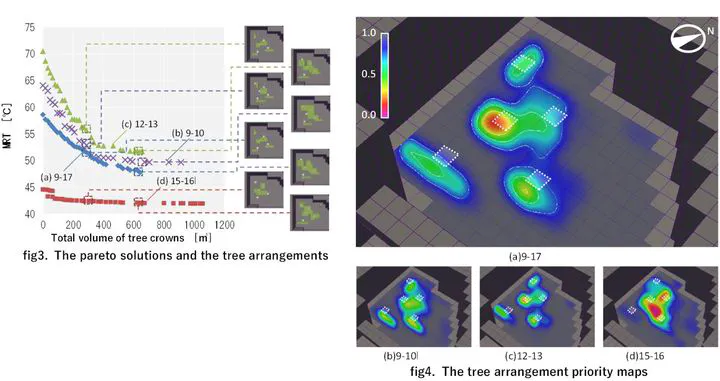Optimization of Tree Arrangement for Landscape Design: Proposal Regarding Tree Arrangement Priority Maps for Heat Mitigation
 Tree arrangement optimization for landscape design
Tree arrangement optimization for landscape design概要
This study is intended to explore the possibility of ‘Algorithmic Design’ that considers heat mitigation in landscape designs. In recent years, simulations of the thermal environment have been increasingly used to study landscape designs. Nevertheless, in most cases, the original plan is not drastically changed by the feedback of simulation results. The heat mitigation effect of the final plan is thus inevitably dependent on the subjective judgments of the designer. In order to derive optimum landscape designs maximizing the mitigating effect quantitatively, a method of generating designs by algorithms that combines optimization and thermal environment simulation is considered to be effective. On the other hand, we expect such ‘Algorithmic Design’ to be an innovative design method that can generate new landscape designs free from stereotypic ideas. In this study, we carried out a trial calculation as a fundamental examination on how to develop a method for optimizing a landscape design. In the trial calculation, we optimized the tree arrangements which we focused on as an important element of the landscape. The trial calculation consisted of a radiation transfer analysis and a multi-objective genetic algorithm. As objective functions of the multi-objective genetic algorithm, we set minimizing the MRT (Mean Radiant Temperature) and minimizing the total volume of tree crowns. The former is an objective function for heat mitigation effects, and the latter is an objective function for reducing costs. The MRT was calculated in 4 time zones (a)9-17, (b)9-11, (c)12-13, (d)15-16 by radiation transfer analysis using the ray-tracing and Radiosity method. As the calculation area where trees were arranged and the radiation transfer analysis was conducted, we set a space surrounded by a U-shaped building (fig1). The 3D-coordinates on the calculation area and the forms of tree crowns were set as design variables of the multi-objective genetic algorithm (fig2). As a result of these calculations, the pareto solutions of the tree arrangements were derived (fig3). From the tendency of the pareto solutions, we were able to find an effective way to manipulate the tree arrangements by which we can minimize the trade-off between the two objective functions. In addition, we made tree arrangements priority maps by superposing the pareto solutions (fig4). The tree arrangements priority maps showed tree arrangements methods for efficient heat mitigation.
タイプ
収録
10th International Conference on Urban Climate/14th Symposium on the Urban Environment
Click the Cite button above to demo the feature to enable visitors to import publication metadata into their reference management software.